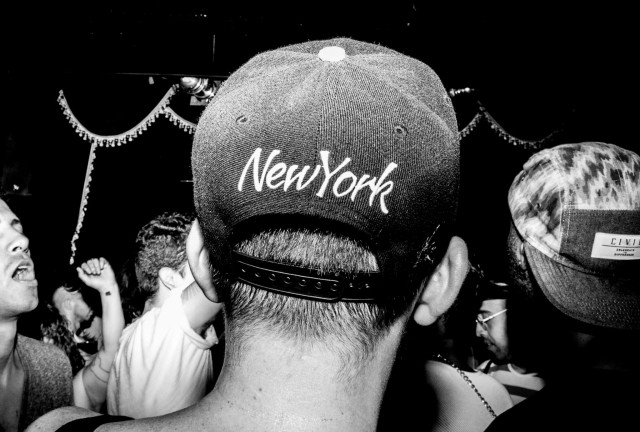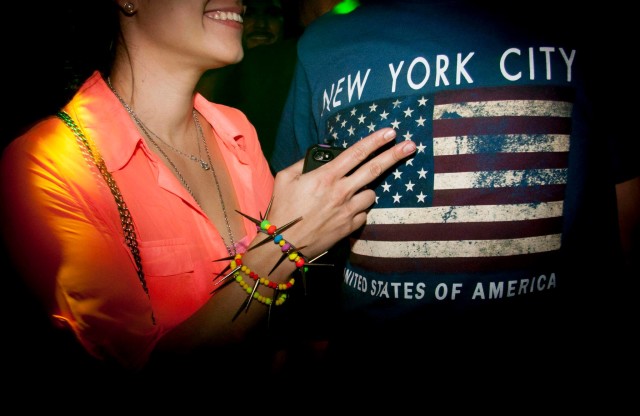
Photos from the author’s monthly Spanish-language dance party Rico Suave
I’ve been working as a DJ and promoter in NYC’s nightlife for a decade. Many of my events are focused on promoting music from Spain and Latin America and, as a result, a lot of my patrons are from Spanish-speaking countries. I love my job because, since I was born in Mexico, putting on events gives me the opportunity to meet people from similar cultural backgrounds. Now I count many of the people I’ve met at work among my closest friends. Also, through Spanish-language nightlife, I’ve come to realize just how much of New York’s art world/cultural workforce emigrated here from Ibero-America.
But unlike many of these friends, most of whom came to the States with a visa, my family moved here with greencards. One thing I’ve learned after mingling with many of my visa-holding friends is how broken, ineffective, and taxing the American visa process can be. I wouldn’t diminish the incredibly difficult struggles of full-on undocumented individuals, but I now know that even when a person follows the proper bureaucratic etiquette, there’s no guarantee of housing, job stability, freedom of travel, or—at the very least—access to clear information.
Antonio, a developer for one of the biggest comic book publishers in the country, knows exactly what it’s like to be a victim of the defective visa system:
“Apparently someone in the American immigration database has a similar name to mine, and that person got in trouble with the American government. While trying to renew my visa in 2011, I went back to Mexico, where I only planned to stay for 3 days, which is the time it normally takes to complete the process. But since the database flagged my name as being someone I’m not, the USCIS had to investigate my identity, and I could not get back to my job because my approval was placed on hold. During the ordeal, trying to get any helpful information from the USCIS office was futile. The process took 3 months, and I was stuck in Mexico for the entire time.”
Oh, sure: being able to take off to Mexico for three months sounds like the perfect vacation—until you remember that you still have to pay incredibly expensive New York rent, and that you’ll probably get fired from your job because no reasonable boss will ever give you that much time off.
Ramón, who was already a working architect back in Mexico, had no choice but to work his way from the bottom:
“From back home, it’s impossible to get hired by an American firm to do anything unless you’re a huge big shot. I came to New York with a tourist visa, worked at a couple restaurants to make ends meet—under the table, of course—until I landed an unpaid internship in a small firm. They liked my work, and offered to sponsor a J-1 trainee visa. Later I was able to switch to a TN visa (special work visa for Canadians and Mexicans), which offers more flexibility but still has to be renewed annually. However, the TN visa is no blessing since the USCIS can arbitrarily deny any renewal. God, I’d be sweating blood every time the expiration date drew near because on a person’s whim—like if the USCIS officer is having a bad day—your life, and all of what you’ve worked for, can be taken away from you instantly. Luckily I got married to an American a few years back, and now I have a greencard.”
Luck seems to play a big role in the visa game. Valeria, a film director, had no issues rolling the dice because she was on a serious winning streak:
“I was given a tourist visa for ten years, and I managed to live in New York for six. Among the odd editing job here and there, I got some freelance work doing short news clips for South American media. Ideally I wanted to find stable work in New York but, since I couldn’t stay in the country for longer than six months at a time (my visa would get revoked if I did), not many companies would take me seriously.”
Valeria’s luck ran out when she went back to Colombia for the seventh time. On her way back, an immigration officer at JFK (she was still allowed to board her flight in Bogota) cut Valeria’s vacation short by revoking her visa and banning her from the U.S. for ten years. Her belongings—video and computer equipment, clothes, furniture, etc—were sold off by Valeria’s roommate in order to cover rent and other bills.
“I was devastated,” wrote Valeria over email:
“The possibility of getting kicked out was always in the back of my head. But losing your friends, work gear, and home all at once is dreadful. Honestly, no amount of anticipation can truly prepare you for such a horrible feeling.”

Photos from the author’s monthly Spanish-language dance party Rico Suave.
Hosting events for Latino film festivals, fashion shows, concerts, and art exhibits, I’ve had professional dealings with an eclectic group of this city’s creative community. Stories of frustration similar to the ones of Antonio, Ramón, and Valeria often shared all across the board. This is just one demographic that is being affected by the inadequacy of the current immigration process in America—a process which hardly makes anyone feel welcome—but I’m sure plenty of non-Latino foreigners find themselves in similar predicaments.
The truth is, the cities that put American art on the map—Miami, Los Angeles, Chicago, San Francisco, and of course, New York—have huge foreign populations. Imagine what would happen to those populations if Donald Trump was elected president (surely you’ve read his xenophobic immigration plan). As AFC’s own Michael Anthony Farley can tell you, conservatives are not ones to take art seriously, so hopefully this insight into my friends’ experiences can help shed some light on an issue which keeps affecting so many creatives. I’d encourage the art world to become more vocal and supportive in the politics of immigration—our city’s cultural life depends on it.


Comments on this entry are closed.
{ 1 trackback }